Blog entries for 2015
November 23, 2015
A whirlwind trip to China
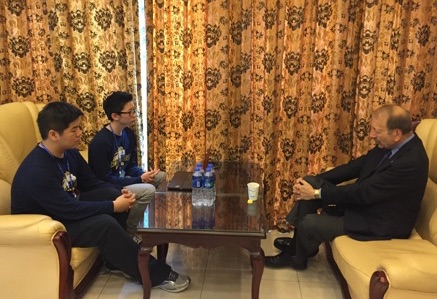
Chancellor Blumenthal was interviewed by two students from Shanghai High School.
Four cities in 11 days! Hardly enough time to adjust to the time difference, let alone get a handle on a country as big and complex as China. But the trip, which was organized around building relationships to foster study and research opportunities for students and faculty, was successful and rewarding on multiple levels.
We met with U.S. Ambassador Max Baucus, representatives of the Ministry of Education and the Chinese Scholarship Council, and attended two receptions with alumni and parents of current students. We visited several high schools and about 10 universities in Beijing, Shanghai, Nanjing, and Hongju.
As I mentioned in my monthly message, much of the itinerary was organized by Astronomy and Astrophysics Professor Doug Lin. Joel Ferguson, professor of computer engineering, senior international officer, and associate vice provost of international education, will be following up on connections we made to support study-abroad opportunities for UC Santa Cruz and Chinese students.
For me, one of my strongest and most lasting impressions is of the students I met. They were unfailingly bright, well-prepared, and eager to engage.
I had been invited to give an astronomy talk at the Beijing American Center, which is part of the U.S. Embassy complex in Beijing; the center hosts public talks every night by visiting American dignitaries and scholars, and about 150 people attended my talk. These drop-in sessions are open to everyone, yet the caliber of questions I fielded suggested many in the audience had a background in astronomy. I thoroughly enjoyed being cornered after the formal presentation by five students who wanted to keep talking and asking questions.
I also gave a talk at Shanghai High School as part of their Career Day, and I was particularly impressed by two student journalists who interviewed me for the school newspaper. They had clearly done their homework.
And no wonder. Students in China compete to get into the most elite public high schools, including Shanghai High School. Only about 1 percent of the population make the cut, and once there, they are in classes from 8 a.m. to 5 p.m. Students in these schools are considered the strongest prospects for overseas study. One school we visited teaches all physics classes in English only, because they consider the United States to be the best place to study physics and don't want their graduates to be at a disadvantage when they compete internationally. Needless to say, I gave my talks in English, but what's remarkable is the audiences didn't need translators.
All of the high schools and university campuses we visited were impressive. Some had the trappings of many American universities, with stately buildings, mature landscaping, and lush, leafy trees that arced over campus roads and walkways. I didn't spy a single Banana Slug, though!
Everywhere we traveled, our hosts were gracious and welcoming, and travel within China was efficient and comfortable. We flew from Beijing to Shanghai, then took the high-speed rail to Nanjing and Hongju. Zipping along at 250 mph in comfortable, clean train cars, I felt like I was getting a glimpse of the future.
The weather was mild, but the traffic was anything but! The roadways are unbelievably crowded, there are no lanes to speak of, and drivers toot their horns constantly. Amazingly, we saw no accidents. The surging river of cars flowed slowly, smoothly, unrelentingly—almost like a symphony, yet no conductor was in sight. I did pity the pedestrians, bicyclists, and anyone on a motorbike, though. How they survive the traffic was beyond my powers of comprehension.
Fortunately, the air pollution wasn't bad when we were in Beijing, though a UCSC alumna told us all flights had been cancelled the week before because of low visibility, so I guess we were lucky.
One final note about the food, all of which was delicious and presented beautifully. I enjoyed it all, especially the seafood, and I ate at least a couple of things I didn't recognize. That's all part of the adventure of overseas travel, right?
August 28, 2015
Congratulations, Claire!
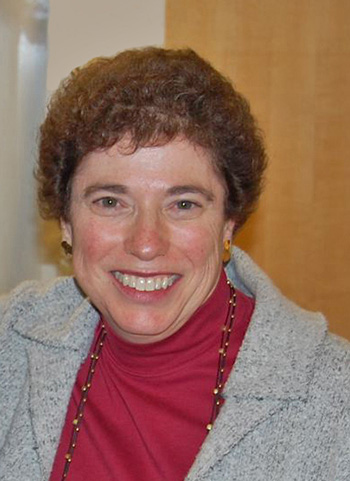
Claire Max
Against that backdrop, it was especially gratifying to hear that UCSC's Claire Max was named director of UC Observatories, our multi-campus research unit. I've known Claire since she was a postdoc at Princeton and I was a postdoc in Boston. We've kept in touch over the years, and I was delighted when she joined the UCSC faculty in 1999.
We are fellow theoretical astrophysicists. Her thesis work focused on an important problem in plasma astrophysics that no one had been able to solve. She did, and I've taught her discovery in classes a number of times. Claire spent years at Lawrence Livermore National Laboratory, where she did great work on inertial fusion before becoming an expert in adaptive optics. We hired her to succeed Jerry Nelson as director of our Center for Adaptive Optics. She is a great collaborator who gets along with people and focuses on finding the best path forward.
UCSC has a strong tradition of welcoming women scientists, and I'm proud that Claire succeeds our colleague Sandra Faber, who served a two-year term as interim director of UCO. Congratulations, Claire!
June 1, 2015
Alumni making their mark in the nation's capital

Kalwis Lo, left, watched as President Obama signed historic legislation tying student loan interest rates to financial market indices.
Kalwis (Stevenson, politics and education, '11) was part of the team that advocated for federal legislation that cut student loan interest rates, and he was in the Oval Office when President Obama signed the historic bill.
As a student, Kalwis served as chair of the Student Union Assembly and credits UCSC with helping him develop strong leadership skills. He was also active in Engaging Education, one of several student-initiated outreach programs that encourage underrepresented high school students to come to UCSC.
Kalwis is a really good guy, and like so many of our graduates, he is keeping in touch and eager to give back to the campus. Earlier this spring, he attended a reception for newly admitted students in the Washington area. I cannot imagine a better ambassador for us.
Kalwis worked in the offices of several members of Congress before joining USSA, which is the largest student-run organization focused on advocating for students in the United States. He isn't the only UCSC alum advocating for students in Washington. Tiffany Dena Loftin (Oakes, American studies and politics, '11) served as president of the USSA before Obama appointed her to the President's Advisory Commission on Educational Excellence for African Americans.
With commencement around the corner, I hope this class will follow in Kalwis and Tiffany's footsteps and keep in touch. Nothing speaks to the value of a UCSC education like the success of our graduates—and nothing makes me more proud than hearing from alumni.
Comments or questions? Write to chancellor@ucsc.edu and put "Kalwis" in the subject line.
April 30, 2015
Alumni Weekend 2015: One for the record books
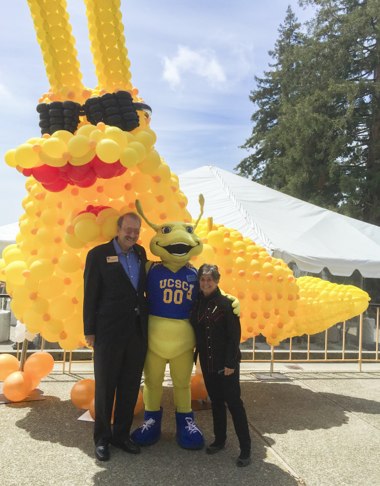
Cowell College Provost Faye Crosby and I got a kick out of the banana slug balloon sculpture created by UCSC alum Addi Somekh. Photo by Margaret McGuire.
This year's Alumni Weekend was billed as the "biggest and best," and the celebration certainly lived up to my expectations. Dozens of events over four days attracted 2,500 guests to campus, including more than 1,000 alumni from across the decades.
Teach-ins, performances, social gatherings, tours, talks, dedications, and great food and drink added up to an outstanding weekend. All weekend, I watched alumni reconnecting with each other, with the campus, and with their experiences here.
Highlights for me included the all-alumni lunch on Saturday, the rededication of Merrill College, which attracted a number of original faculty, as well as alum Taiko drum player Kenny Endo who came all the way from Hawaii, and the Dizikes Concert featuring tunes from 1965 on Sunday--though I suspect Cowell Provost Faye Crosby regrets inviting me to dance!
It was a genuine honor to present the Alumni Achievement Award to M. Sanjayan (Biology, Ph.D, '97). A warm and engaging speaker, he gave a great talk about conservation to a full house in the Media Theater. He kept the audience spellbound with clips of the new PBS series he hosted, Earth: A New Wild. If you haven't watched it, I highly recommend it.
I was also delighted to participate in the presentation of the Social Sciences Division's Distinguished Alumni Award to Steve Bruce (Economics, B.A., '79). Steve is a Santa Cruz local who has been a generous supporter of the Social Sciences for many years.
Congratulations to all who worked so hard and long to organize and pull off the success! Check out a selection of "photographer favorite" photos from the weekend, as well as the ever-popular Alumni Weekend Photo Booth.
Comments or questions? Write to chancellor@ucsc.edu and put "Alumni" in the subject line.
April 9, 2015
Craig Haney questions authority throughout his career
Craig has spent his entire career documenting the dramatic escalation of incarceration in the United States, a period during which he has advocated for greater compassion and justice in the criminal justice system.
Craig delivered his remarks to a full house in the Music Center Recital Hall under the auspices of the 49th Faculty Research Lecture, an event that celebrates faculty excellence and the research mission of the university.
The scale of what Craig described was astonishing: A prison population that has soared over the past 40 years despite little change in crime rates or the numbers of people arrested. We routinely lock up the mentally ill, people of color are disproportionately represented in prisons, and conditions are beyond grim as overcrowding and a shift in mindset from rehabilitation to overt punishment have become the norm. The United States is such an outlier on the world stage that even if we cut our prison population in half, he said, we would still have the second-highest prison population in the world.
Fortunately, Craig sees signs that public policy—and public opinion—might be changing. In a landmark case to which Craig contributed, the U.S. Supreme Court ruled in 2010 that conditions inside California prisons constituted cruel and unusual punishment and must be improved, and a recent Bipartisan Summit on Criminal Justice Reform in Washington, D.C., attracted a diverse, bipartisan audience, all of whom were calling for reform.
Hats off to Craig for bearing witness for nearly four decades. And kudos to this campus for nurturing pioneers like Craig Haney, whose courage, compassion, and commitment enable us to reconnect with our humanity.
Comments or questions? Write to chancellor@ucsc.edu and put "Haney" in the subject line.
March 10, 2015
Anita Hill: Meeting a personal hero
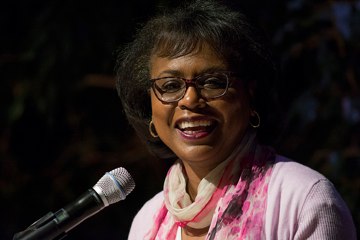 Anita Hill attracted an overflow crowd. Photo by Tosh Tanaka.
Anita Hill attracted an overflow crowd. Photo by Tosh Tanaka.March is Women's History Month—an ideal time to reflect on the recent visit to campus of Anita Hill.
Like millions of Americans, I was glued to the television during her 1991 testimony before the Senate Judiciary Committee during the confirmation hearings for Supreme Court nominee Clarence Thomas. She was such a credible witness—even as she was being railroaded by the all-male, all-white members of the committee. I was offended by the committee's treatment of her.
My wife Kelly and I so admired Anita Hill's courage and composure throughout the hearing. She has been a hero to both of us ever since. And so it was truly an honor to meet her and host her on campus. Her keynote address attracted a crowd that quickly filled the Multipurpose Room at Colleges 9 and 10, as well as the Humanities Lecture Hall, where it was simulcast live. Kudos to event organizers who swiftly found yet another room to accommodate everyone who turned out to see her.
Strikingly, as defining a moment as that hearing was in her life and as high a price as she has had to pay for coming forward as she did, Anita Hill has dedicated her life to empowering women. She shed public light on the pervasiveness of sexual harassment and has been a spokeswoman for women, minorities, and people who have been badly treated in myriad ways ever since. What an accomplishment to pivot from the ordeal of that hearing to her role as an advocate fighting for the principles in which she believes. Strikingly, she is friendly, warm, generous, and compassionate. In short, she is a role model for us all.
Comments or questions? Write to chancellor@ucsc.edu and put "Hill" in the subject line.
February 18, 2015
Turning 95 in style
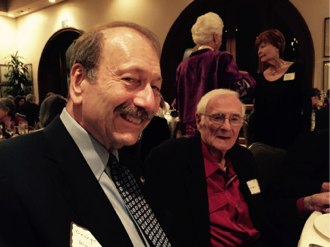
Ninety-five guests attend the party in Santa Barbara, including four generations of Sinshimer family members, many friends, colleagues, and former students. I was a relatively junior faculty member during Bob's tenure as chancellor, but he brought transformational leadership to the campus at a key turning point. I spoke of his success solidifying our standing with the Office of the President during a tense moment when budget cuts were prompting public discussion about the possible closure of a campus. Bob also oversaw growth in academic programs, the doubling of graduate enrollment from 350 to 700 students, and the expansion of areas that would become defining parts of our research identity, including linguistics, high-energy physics, seismology, agroecology, and applied economics. There's no honoring Bob's years as chancellor without also celebrating his wife Karen, who brought tremendous warmth and grace to the position.
Of course, one of the most enduring impacts Bob had on the campus wasn't even intentional: It was Bob who made the audacious suggestion in 1985 during an international scientific conference hosted by UCSC to sequence the entire human genome. No one could have anticipated the critical role Santa Cruz would play in that challenge, or the excellence that followed our triumphant success. Professor Emeritus Harry Noller of biology described Bob's vision and what it has meant to the campus.
Other guests included Art Graham, Bob's college roommate at MIT and a good friend to UCSC; Reg Kelly, a former student at CalTech; and Julie Dryden-Brown, Bob's former administrative assistant at UCSC, and Julie's husband George Brown.
There was a lot of love in the room, and I felt honored to be part of the celebration.
Comments or questions? Write to chancellor@ucsc.edu and put "Sinsheimer" in the subject line.
January 27, 2015
Students for a sustainable future
I met recently with students Alden Phinney and Margaux Schindler from the Fossil Fuel Coalition, along with Environmental Studies Professor and College Nine and College Ten Provost Flora Lu.
Alden and Margaux are at the forefront of the Fossil Free UC movement, making the case for divestment from fossil fuels as a strategy to combat climate change. I was very impressed by their energy and commitment.
The sustainability movement at UC Santa Cruz is an impressive collaboration among students, staff, and faculty. It has always been that way. Many UC Santa Cruz faculty members signed the UC Faculty Open Letter to the Regents about fossil-fuel divestment last fall. The letter called upon Regents to freeze new investments in the 200 fossil fuel companies with the largest carbon reserves, to develop a complete divestment plan as quickly as possible, and to invest in climate solutions.
The Regents did not agree to fossil fuel divestment, but they did agree to increase their investment in companies offering climate solutions, which is at least a small victory for our students. I know Alden and Margaux remain determined to see the Regents approve full fossil fuel divestment, and I have little doubt that we are all well on our way toward understanding that fossil fuels cannot remain a part of our collective future.
This Friday, February 13, is Global Divestment Day. Fossil Free UC leaders have planned a mock wedding to demonstrate the "unholy matrimony" of UC and the fossil fuel industry. The ceremony is scheduled for noon in the College 8 quad, with an informational reception to follow. The event is designed to raise awareness and to bring together various groups working on climate solutions.
Alden and Margaux are persistent, driven, and creative advocates of a sustainable future. It was truly inspiring to talk strategy with them.
Comments or questions? Write to chancellor@ucsc.edu and put "Divestment in the subject line.
January 27, 2015
Tribute to Dean and Jane McHenry
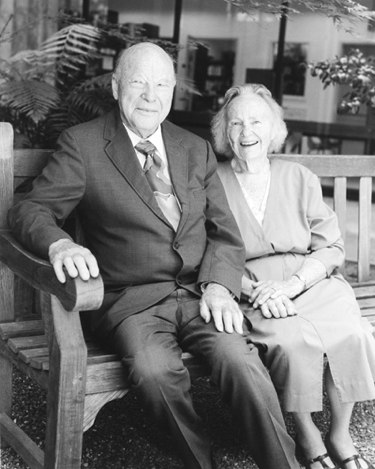
Founding Chancellor Dean McHenry and his wife Jane were photographed in the courtyard of McHenry Library in 1997. Photo by Greg Pio.
Quite a group turned out today to share stories and memories of founding Chancellor Dean McHenry and his wife Jane. Nothing quite compares to the recollections of people who knew this dynamic duo.
Take economics professor and founding Stevenson College Provost David Kaun's story about the "revolutions in the dorms." McHenry was devoutly religious and became quite concerned over the years as the residential divisions on campus between men and women broke down. At first, the sexes were segregated in completely separate buildings located at opposite ends of the hills of Cowell and Stevenson colleges. Then dorms became integrated, and finally individually floors went co-ed, which raised all kinds of questions about bathrooms that McHenry found positively baffling. Times changed, and ultimately, McHenry did, too.
It was great to hear founding Vice Chancellor of Business and Finance Hal Hyde recount stories of the earliest days of the campus. And Bill Doyle, a founding faculty member who has recently written two books about the founding and early history of UCSC, explained some of the factors leading to the establishment of our university in Santa Cruz.
Dan Aldrich, our former assistant chancellor of University Advancement, reminded guests that McHenry, a native of Southern California, had run unsuccessfully for Congress and had subsequently hoped to be the first chancellor of the new UC campus in Orange County. But his left-leaning political views were too liberal for that conservative enclave, either in Congress or at UC Irvine, and the rest is history—fortunately for us.
Astronomer John Faulkner regaled the crowd with tales of McHenry's remarkable memory. John, who served at one point on the Committee for Academic Personnel, described discussing faculty cases with McHenry and being floored by Dean's ability to quote verbatim from faculty files without even opening them.
For me, it was a pleasure to read a greeting and remembrance from Herman Blake, founding provost of Oakes College. Herman described guiding Dean and Jane through the Gullah Geechee community of Daufuskie Island in South Carolina, a remote barrier island off the Atlantic Coast that had become familiar to UCSC because many students interned there, living in the homes of descendants of Africans enslaved there generations before. The day-long tour had ended with an impromptu conversation on the front porch of a woman who was picking boiled crabs, with Dean sitting on the edge of the porch and Jane rocking in a wooden chair. The free-ranging conversation wandered to the topic of winemaking, and a lively exchange ensued. The McHenrys, of course, were winemakers themselves. Later, during the return trip to the mainland, Jane and Dean were animated and energized, reflecting on the sights and sounds and surprises of the day. Herman said he always remembers them that way: together, fully immersed in the creative adventure of life.
For my part, I told the story of being called to the chancellor's office shortly after my arrival on campus in April 1972. I was intimidated and worried, wondering what I'd done wrong. But I showed up, with my long hair and my long beard, and it turned out McHenry just made a point of personally welcoming each new faculty member to campus. Now, as chancellor, I try to keep that invitation from McHenry in mind when I call people to my office. It can be nerve-wracking, after all.
Kudos to Emeriti Faculty Association president Michael Nauenberg for bringing us together, and thanks to the Arboretum for hosting the gathering.
Comments or questions? Write to chancellor@ucsc.edu and put "McHenry" in the subject line.
January 23, 2015
Dress up and dance like it's 1965

Retro hairdos, hats, props, and selfies were the order of the day on Dress Up Like it's 1965 Day. Top two photos by Carolyn Lagattuta.

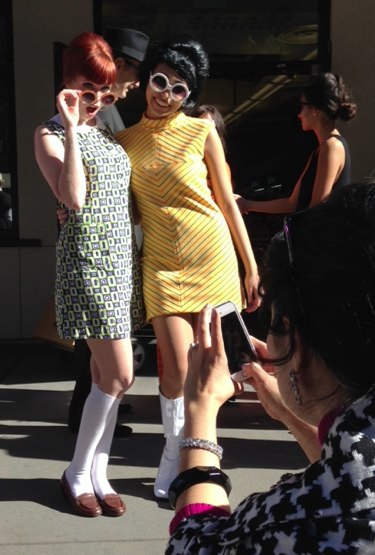

I haven't seen so many beehive hairdos, white gloves, and skinny ties since, well, 1965!
The campus kickoff last week of our 50th anniversary was thoroughly entertaining. The theme was "Dress Up Like it's 1965," and we did. I donned a black fedora, skinny tie, and dark-rimmed glasses. Campus Provost/Executive Vice Chancellor Alison Galloway outdid me by a mile with a vintage I. Magnin coat, pearls, a pillbox hat of her own making, and period sunglasses she couldn't even see out of because they were someone else's prescription. Talk about sacrificing for fashion!
A group of us walked from Kerr Hall to Quarry Plaza, where we were met by dozens of students in a range of outfits from beatnik to mod. KZSC was blasting tunes from 1965, dancers in mini skirts and go-go boots were twisting and shaking, and everyone posed for many, many photos. Alumna Tiffany White Stanton, who designs costumes for Mad Men, couldn't make the party so she reviewed photos to pick the winners of the most authentic 1965 costume. She had her work cut out for her, but check out the results online.
And true to the era, a group of students protesting the proposed tuition hike marched through the plaza chanting and banging drums. As Kevin Karplus, a professor of biomolecular engineering, was quoted in the Santa Cruz Sentinel article saying of the student demonstration, "It wouldn't be the '60s without one."
If the rest of our 50th year is half as much fun as the kickoff, we'll be in great shape. The month will wrap up with more five anniversary-related events: a remembrance of founding Chancellor Dean McHenry on January 27; the inaugural conversation in the new Questions that Matter series on January 27; Angela Davis will be the keynote speaker at the Martin Luther King, Jr. Convocation on January 28; and Cowell College will celebrate "Three Generations of Smiths," including founding provost Page Smith, on January 30. Full details are available online.
Comments or questions? Write to chancellor@ucsc.edu and put "Kickoff" in the subject line.
January 20, 2015
Marketplace of ideas
January 20, 2015
I want to reiterate my commitment to the university as a marketplace of ideas by posting here my statement about free speech:
In light of past and current events sponsored by—or taking place on—the campus, it is important that we remember that the university is—above all—a community of free inquiry and the free exchange of ideas.
A central function of the university then becomes fostering in its students a mature independence of mind. By policy (APM 010) and practice, the university rigorously honors the freedom to present the widest range of viewpoints irrespective of agreement on those viewpoints.
The opportunity for constructive debate on the merits of different viewpoints is essential to the advancement of knowledge. More importantly, the university honors the freedom to present the widest range of viewpoints without implying agreement or endorsement of the same.
Comments or questions? Write to chancellor@ucsc.edu and put "Speech" in the subject line.
January 15, 2015
Students hack their way to success
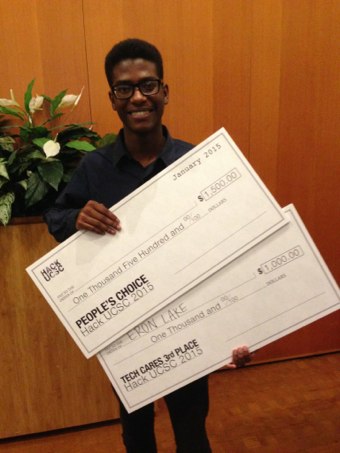 People's Choice Award winner Eron Lake developed a video game to help high school students learn cell biology. Photo by Paige Welsh.
People's Choice Award winner Eron Lake developed a video game to help high school students learn cell biology. Photo by Paige Welsh.By now, I hope the participants in last weekend's UCSC Hack event have recovered from the lack of sleep they endured in pursuit of the next great app. What an impressive event: Nearly 400 students from UCSC, Cal State Monterey Bay, and even a few from as far away as the East Coast, two dozen sponsors, and an extraordinary amount of talent filled the Merrill Cultural Center.
I was impressed by all of it, but a couple of projects really stood out, including People's Choice Award winner Eron Lake, a one-man team who developed a video game to help high school students learn cell biology. SlugBus was another winner, which I'm sure UCSC shuttle riders would appreciate. It uses peoples' smartphone data to determine the timeliness and location of campus buses and shuttles—and their capacity to pick up additional passengers, too. Finally, Avi Varshney took first place in the innovation category for creating a robot that responds to its operator's motions; when Avi raised his right arm, the robot raised its right "arm."
By Sunday evening's award dinner, the room was a sea of blue with participants sporting their Hack UCSC 2015 t-shirts. Students were pretty exhausted, but the energy in the room was great as finalists presented their projects.
Word is clearly out about this event, which quadrupled in size from last year's inaugural hackathon. So many people came together to make the hackathon possible. Kudos to organizer Doug Erickson of Santa Cruz New Tech MeetUp, Bonnie Lipscomb of the Santa Cruz Economic Development Office, Lila Tretikov, executive director of Wikipedia, and all our sponsors. Brent Haddad, who runs our campus Center for Entrepreneurship, recently won a United Way Community Hero Award for his efforts to boost local employment; I think he deserves another award for Hack UCSC 2015.
Two weeks after last year's hackathon, half the participants had received a job or internship offer. That may be hard to replicate, but there's no doubt in my mind that this year's hackathon will spark some great collaborations and generate some new apps.
A full list of winners is available on Santa Cruz Tech Beat's website, thanks to alumna Sara Isenberg.
----
Comments or questions? Write to chancellor@ucsc.edu and put "Hackathon" in the subject line.
